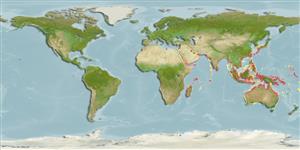>
Anguilliformes (Eels and morays) >
Ophichthidae (Snake eels) > Ophichthinae
Etymology: Pisodonophis: Greek, piso, pipisko = to drink + Greek, odous = teeth + Greek, ophis = serpent .
More on author: Hamilton.
Environment: milieu / climate zone / depth range / distribution range
Ecologia
marinhas; Água doce; estuarina demersal; anádromo (Ref. 51243); intervalo de profundidade 0 - 10 m (Ref. 86942). Tropical
Indo-West Pacific: Somalia (Ref. 30573) and Tanzania south to Knysna, South Africa (Ref. 3972), including the Seychelles (Ref. 7245); also southern India and Sri Lanka (Ref. 7245). Widespread elsewhere from the east Indian coast throughout Indonesia to Polynesia (Ref. 7245).
Tamanho / Peso / Idade
Maturity: Lm ? range ? - ? cm
Max length : 100.0 cm TL macho/indeterminado; (Ref. 3972); common length : 70.0 cm TL macho/indeterminado; (Ref. 7245)
Descrição suscinta
Chaves de identificação | Morfologia | Morfometria
Espinhos dorsais (total) : 0; Espinhos anais: 0; Vértebras: 171 - 180. Diagnosis: Body snake-like, cylindrical, compressed only along extreme tail tip; anterior nostril tubular, posterior along lower edge of lip; teeth granular to molariform, multiserial bands on jaws and vomer, but sharper on jaws and more pointed in young individuals; median fins not continuous posteriorly; extreme tip of tail stiff and finless; dorsal fin origin about a pectoral fin length behind tips of pectoral fins; lateral line inconspicuous (Ref. 4832).
Found in lagoons and estuaries, entering freshwater and paddy fields (Ref. 7245, 30573). Common in tidal reaches and nearby upstream areas of coastal rivers (Ref. 12693). Lives in holes in the river bottom and bank and actively forages for small fishes at night (Ref. 12693). Reported to spawn in rice-paddies during the rainy season (Ref. 12693). Caught in bag nets and similar gear. Marketed fresh.
Ciclo de vida ou comportamento de acasalamento
Maturities | Reprodução | Spawnings | Egg(s) | Fecundities | Larvas
Castle, P.H.J., 1984. Ophichthidae. p. 38-39. In J. Daget, J.-P. Gosse and D.F.E. Thys van den Audenaerde (eds.) Check-list of the freshwater fishes of Africa (CLOFFA). ORSTOM, Paris and MRAC, Tervuren. Vol. 1. (Ref. 3508)
Status na Lista Vermelha da UICN (Ref. 130435)
Ameaça para os humanos
Harmless
Uso pelos humanos
Pescarias: pouco comercial; isca: usually
Ferramentas
Relatórios especiais
Baixar XML
Fontes da internet
Estimates based on models
Preferred temperature (Ref.
123201): 24.6 - 29.2, mean 28.5 °C (based on 2626 cells).
Índice de diversidade filogenética (Ref.
82804): PD
50 = 0.5020 [Uniqueness, from 0.5 = low to 2.0 = high].
Bayesian length-weight: a=0.00093 (0.00047 - 0.00184), b=2.97 (2.80 - 3.14), in cm total length, based on LWR estimates for this species & (Sub)family-body (Ref.
93245).
Nível Trófico (Ref.
69278): 4.0 ±0.71 se; based on food items.
Resiliência (Ref.
120179): médio(a), tempo mínimo de duplicação da população 1,4 - 4,4 anos (Preliminary K or Fecundity.).
Fishing Vulnerability (Ref.
59153): High vulnerability (60 of 100).
